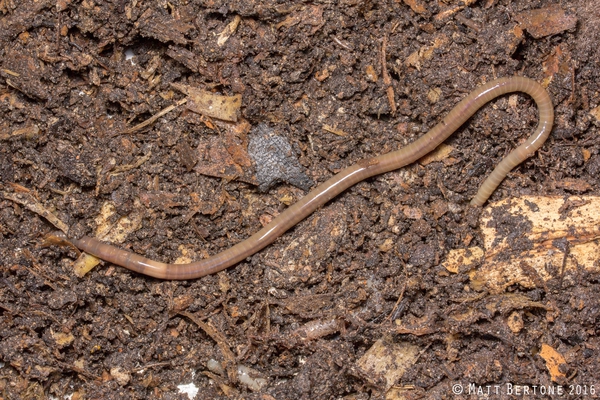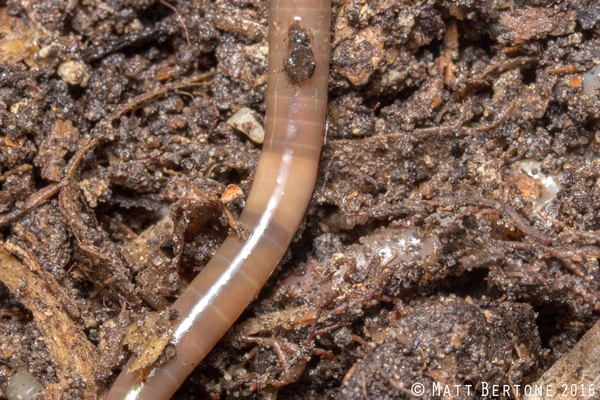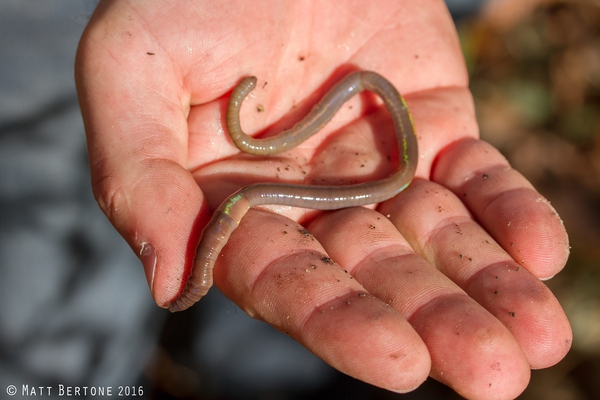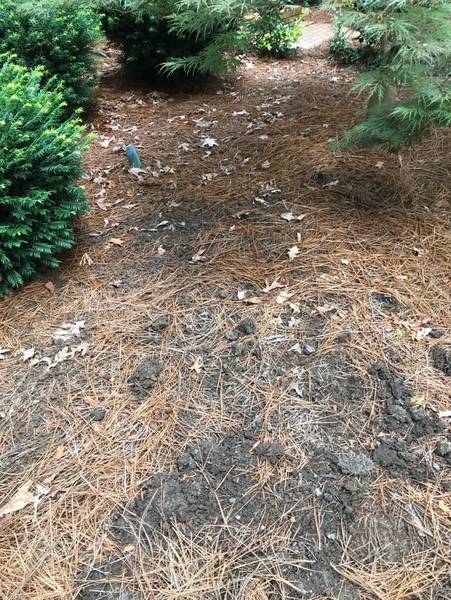Introduction
Although earthworms (terrestrial oligochaetes) are supposed to be a gardener's best friend, many species in the United States are not native and some are destructive. One of the most notorious groups of earthworms are the so-called "Asian crazy / jumping" worms (referred to as "jumping worms" from here on out), known locally sometimes as snake worms, Alabama jumpers, and Georgia jumpers. Despite some of these names, jumping worms are native to regions from East Asia through Australia, but have been moved by humans all over the world, especially in soil and planting pots. They are in the family Megascolecidae, and the most often referenced species is Amynthas agrestis, though there are other species in that genus and other related genera (e.g. Amynthas tokioensis and Metaphire hilgendorfi) that can be common. Multiple species can even be found together in landscapes.
Despite news reports suggesting these worms are new to the United States and North Carolina, jumping worms have been in the country since at least the late 1800s. Amynthas agrestis has been in the United States since 1939 (first found in Baltimore, MD; Chang et al. 2016) and recorded in North Carolina since at least 1978 (Reynolds 1978). These worms may be locally abundant but appear to be patchy and unpredictable in their presence.
Description
Jumping worms (Figure 1, Figure 2, Figure 3 and Figure 4) represent a diverse group with several species known in North Carolina. The three most common species (Amynthas agrestis, Amynthas tokioensis, and Metaphire hilgendorfi) are all larger worms when mature, from 1-7" in length (30-170 mm) with a body width of 1/8-1/3" (3-8 mm). However, smaller species of jumping worms do exist.
Earthworms are difficult to ID by non-experts, as it's often required to dissect specimens or use microscopes to see details on the body. Jumping worms can generally be told apart from other earthworms by the following characteristics:
- often brown in color with a light, cream-colored saddle (Figure 1, Figure 2, Figure 3 and Figure 4); some have an iridescent sheen (Figure 4)
- the "saddle" (clitellum) is near the head region, flush with the rest of the body, and goes entirely around the earthworm (Figure 2) [Note: the saddle is only seen in mature earthworms]
- a single band of short, stout hairs entirely surrounds most body segments; may need hand lens or microscope to see (can be seen on some segments in Figure 3 and Figure 4)
Despite being called "jumping" or "crazy" worms, only some species flail in response to being disturbed. Also some other types of worms behave erratically when touched or approached. Thus the jumping behavior is not always the best way to identify these earthworms.
Biology
Unlike many earthworms that burrow in the soil, jumping worms feed on or near the suface of the ground, consuming large quantities of leaf litter and leaving only castings (earthworm feces) behind (Figure 5, Figure 6 and Figure 7). They can also feed on mulch. Because of this behavior, jumping worms can disrupt natural ecosystems and home landscapes (see Impacts and Management, below, for more information)
The most common species of jumping worms in North Carolina are parthenogenetic, meaning they reproduce without mating. This may be why they can attain high densities in an area. Jumping worms are considered annual species, only having a single generation per year. They produce dozens of small, round structures containing eggs (referred to as cocoons) in the fall, that overwinter as the adults die out (Chang et al. 2021). These cocoons are dark brown and about 3 mm in diameter, about the size of a mustard seed. The cocoons / eggs hatch in the spring and the worms grow throughout the year. Thus, adults and their activity may not be seen until later in the year.
Impacts & Management
Jumping worms can sometimes be extremely abundant, both in developed and natural areas, consuming large amounts of leaf litter and surface organic matter. This, and other activities, pose several problems. Jumping worms may cause imbalances in soil nutrition as well as sequester toxic metals from the soil which can accumulate in predators who eat them. The removal of surface organic matter is also a major risk to other organisms. It eliminates the food source for many other animals, including millipedes, springtails, and other invertebrates (which can further affect predators up the food chain). Removing leaf litter on the soil surface also decreases habitat for salamanders, ground-nesting birds, plants, and many other species, which has a negative impact on native biodiversity. Finally, jumping worm activity can cause changes in the physical characteristics of soil, contributing to erosion and changes in water permeability.
It is difficult to control jumping worms when they are already present in an area. There are no chemicals available for controlling earthworms, and compounds that might work against jumping worms would also kill other earthworms. Leaf litter can be raked aside and any jumping worms can be hand removed and placed in a bucket of soapy water, rubbing alcohol, in a freezer, or in a bag left out in the sun to kill them. This can remove at least some of the individuals from the environment, which may help reduce future populations.
The most important form of management is preventing the worms from establishing in an area in the first place. This can be done several ways:
- when purchasing mulch and other ground cover, make sure it is free of worms and cocoons (if possible); composted materials that attain proper, high temperatures for the right amount of time (104-130°F for three days) can kill cocoons, reducing the risk of them coming in on such materials
- when buying plants, inspect the soil for worms or cocoons; purchasing plants with bare roots can help avoid contaminated soil
- refrain from swapping plants dug up from the ground, leaf litter, and soil with neighboors
- avoid purchasing jumping worms for fish bait; accidental releases can allow them to invade new areas
- clean soil from items, vehicles, etc. that are being moved from one area to another, especially if the area of origin has jumping worms present
Remember, if it has soil, it can have jumping worms!
References
Chang, C. H., Snyder, B. A., & Szlavecz, K. (2016). Asian pheretimoid earthworms in North America north of Mexico: an illustrated key to the genera Amynthas. Zootaxa, 4179(3), 495-529.
Reynolds, J. W. (1978). The earthworms of Tennessee (Oligochaeta). IV. Megascolecidae, with notes on distribution, biology and a key to the species in the state. Megadrilogica, 3(7), 117-129.
Chang, C. H., Bartz, M. L., Brown, G., Callaham, M. A., Cameron, E. K., Dávalos, A., ... & Szlavecz, K. (2021). The second wave of earthworm invasions in North America: biology, environmental impacts, management and control of invasive jumping worms. Biological Invasions, 1-32.
Publication date: Sept. 2, 2021
N.C. Cooperative Extension prohibits discrimination and harassment regardless of age, color, disability, family and marital status, gender identity, national origin, political beliefs, race, religion, sex (including pregnancy), sexual orientation and veteran status.







